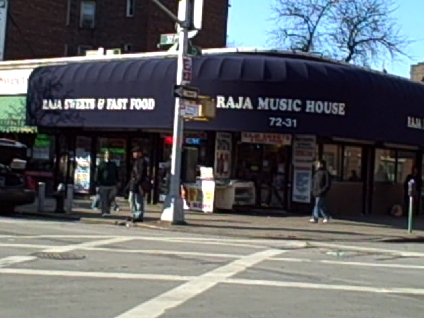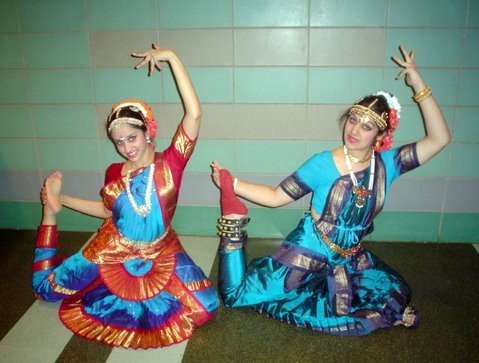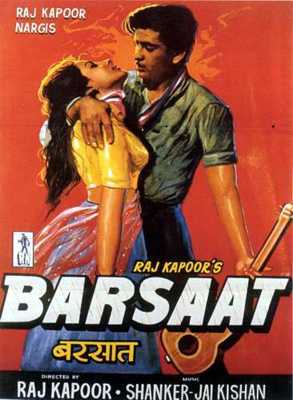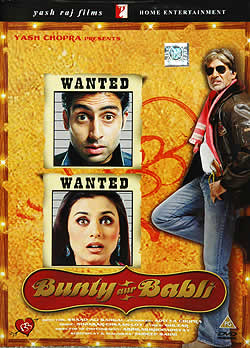From The Peopling of New York City
“To some extent, Bollywood music is used as a social component in my life and makes it easier to relate to an individual because of the common similarity that is found. But that does not mean that everything is common among us… people of all religions, ethnicities, and races listen to Bollywood music.” -17 year old Bengali-American teen
Bollywood Music - A Focus On Indian and South Asian Culture
Analogous to America’s Hollywood, the Bollywood industry is renowned for their production of many Indian cinema. Branching from this film enterprise and just as famous is the Bollywood music industry. It is difficult to find a Bollywood movie that does not include choreographed dancing and singing, as most of these movies are in the form of musicals. And so, Bollywood music refers to the soundtrack that comes from Bollywood films.
With much of the entertainment including film, dance, and music, the image of the Bollywood industry scales across areas of Indian culture. For example, because Bollywood music is visually performed in films, the music is becomes more well known apart from their audio soundtrack. Bollywood is uniquely Indian because many forms of dance and theatre, for example, come from Indian origins. This does not mean, however, that Bollywood music and film belong only to the Indian ethnicity. Currently, many Bollywood music are performed by other musicians of South Asians backgrounds, not just Indian.
“I mentioned that the songs are not always Hindi or that the music is from composers and singer of India because the Bollywood industry has reached to all parts of the world…” – 17 year old Bengali-American teen
As found in this interview, Bollywood music transcends boundaries to reach listeners of all South Asian ethnicities, and even some non-South Asians, even though the actors, singers, and dancers in the Bollywood industry are mostly South Asian. Like most of the film dialogue, the music in Bollywood movies is mostly in Hindi. However, more and more contemporary films are using English, and then translating the dialogue and lyrics later on into Hindi, or would stick to English and switch later on into Hindi depending on the scene of the film. Still, the use of the Hindi language is a feature that distinguishes Bollywood music from other genres, marking its ethnic authenticity.
“If there were no long songs, it wouldn’t be a Bollywood movie. It’s as simple as that. I have people ask me how I could sit through that, but it makes the film genre unique.” – Samantha Shetty
As films are reflective of South Asian culture, it also holds true that the music also is representative of similar themes and messages seen in their respective movies. Most of the music deals with themes of love in the romantic sense, although traditional Indian customs support arranged marriages that are usually based on the parental wishes of the man and woman. Still, many avid fans enjoy Bollywood songs about love.
Interestingly enough, the commercialism of the Bollywood image does not wholly take away from the unique South Asian culture that defines it, unlike many Hollywood and popular western culture that focus more on an iconic success. At the same time, however, transnationalism exists between South Asian Bollywood culture and the American image. We see proof of this in Jackson Heights’ “Little India,” where many posters are seen that display movie characters that experiment with an American lifestyle, such as in the current 2009 film delhi-6. Although more modern Bollywood cinema combines westerns ideas and style, many South Asian fans, both afar and here in the U.S., still follow this subculture and the trends, such as fashion, that are a part of this industry.
Maintaining an Image - Blending Classical and Western Forms
Early Bollywood musical scenes showcase the classical Indian form of dance. The sacred Hindi style of musical theatre is called Natya, and it includes forms of singing and miming, as well and dancing. Classical Indian dance includes several different forms: Bharantanatyam, Odissi, Kuchipudi, Manipuri, Mohiniaattam, Sattriya, Kathak, and Kathakali. These forms of dance are traced from different regions around India, and are documented as a performing art in India (Rajan, 2007).[1] More modern Bollywood films, however, are using more western forms of dance, akin to Broadway musicals, and blending them with the classical styles of Indian dance.
“I think that it’s important to fuse the times and styles together. As long as people don’t lose touch with the original pieces of art. I like classical music the most, personally. I’ve had the best experiences performing it on stage.” – Samantha Shetty
While the blending of Americanized styles of dance and music, such as hip-hop, with classical Indian forms seems to be popular on a commercial scale, some faithful South Asian fans still prefer tradition. In an interview with Samantha Shetty, a member of Hunter College's Desi Club, she mentions that she enjoys classical Indian music the most because of her experiences performing with it on stage. For many South Asians, like Samantha Shetty, this music is special in that it celebrates their culture, regardless if they reside in South Asia or in the U.S. The music is also a means to show Indian pride, as discussed in an interview with an 18 year old Indian-American student. She compares this pride with an American ideal: "I think that most South Asians give rise and feed into the Bollywood industry because they take pride in their culture and want to see it go far, like entertainment industries in other countries such as the US."
There is also a sense of following between the cultures of South Asia and here in the U.S. The late 20th century was a time when more immigrants, like South Asians, moved into the U.S. to begin a new lifestyle. While there are factors that do attract people to immigrate (economic opportunity, safety, etc.), cultural pride is one aspect that is difficult to eliminate. Found in the interview with an 18 year old Indian American teen, pride, in no exception, follows many South Asians who do immigrate to the U.S. Since the Bollywood industry is able to appear and impact even the western world, the ethnic influence - language, music, dance, costumes - is instilled within the fans who adore it. Therefore, while the recent Bollywood films are integrating more western styles, they still maintain their South Asian image.
Movies and Videos - Visualizing Bollywood Music
As with most mainstream American popular music, Bollywood music is often visualized through music videos, and more importantly, in the movies they come from. These videos and movies are visuals that not only enhance the music that is heard, but the South Asian culture as well.
Playback singer Alisha Chinai, sings the female voice of actress Aishwarya Rai in the song, “Kajre Re,” from the film, Bunty Aur Babli (2005), with actors Amitabh Bachchan and Abhishek Bachchan. Interestingly enough, playback singers only provide their voice to the music, so that the actors and actresses in the movie lip-sync to the recording. While these musicians are not featured in the movie, the actors and actresses that perform in the musical numbers dress in Indian costumes and dance to choreography of an Indian style. We see this clearly through the women in Bollywood films, like in Bunty Aur Babli, who dress in Indian-style dress with gold jewelry and sequined outfits. By featuring eastern forms in many Bollywood films and music videos, viewers get a sense of an Indian and South Asian influence portrayed through music and visuals. On the other hand, the lead male actor in movie clip above is wearing a leather jacket and aviator sunglasses, recognizable images of western culture. Integrating these American symbols within a South Asian Bollywood film shows an acceptance and a move towards westernizing their ethnic appearance. Additionally, many Bollywood films in the commercial market include English subtitles in both the dialogue and musical lyrics. This has the ability to reach out to not only South Asians living in South Asia, but to American South Asians here in the U.S. who may or may not speak Hindi, and to fans in other parts of the world. As mentioned by a 17 year old Bengali-American teen, "...people of all religions, ethnicities, and races listen to Bollywood music." Bollywood is an international industry watched all over the world.
A Sense of Community - Listening to Bollywood Music Together
'“I've been listening to Bollywood music ever since I was young so I feel very comfortable with it.” – 18 year old Indian-American teen
From interviews of two young South Asian-American teens, one Indian and one Bengali, both young women were introduced to Bollywood music at young ages. They began listening to the music with family, with either siblings or parents, from Bollywood films that were watched at home. Evidence of an ethnic community through Bollywood music is most clearly seen in the home, not to a surprise that many Bollywood films stress the value of family.
“Since I am a teenager, just like all American teenagers, Indian teenagers can also make friends and meet one another by listening to similar types of music.” – 18 year old Indian-American teen
Both teens also mention the use of Bollywood music acting as a “social component” in their lives. Like in many social settings, finding a commonality between a two separate people is just the beginning to creating a relationship. In an interview with the 17 year old Bengali teen, the interest in Bollywood music has made it easier for her to relate to not only Indians, but to all South Asians who are fans of this music. Additionally, the American-Indian student from CUNY Queens expresses the “comfort and familiarity” with Bollywood music that enables her to enjoy listening to it while she relaxes, as well as when she is having fun at a party. For many South Asians, this “familiarity” with Bollywood music, because of its South Asian origins, plays a significant role in creating ethnic ties based upon these interests.
In a recent neighborhood survey of Jackson Heights' "Little India", there are four businesses that sell Bollywood music, movies, and other merchandise. Even though listeners are more recently purchasing music and films over the Internet, the entertainment businesses in Jackson Heights still find ways to attract customers with blasting music and movie posters. For many South Asians, like the teens in the Bollywood Music Interviews, having this community that can enjoy Bollywood music and film is a warm feeling. Importantly, it gives many a sense to relate to because of similar ethnic origins.
Lyrical Analysis - "Hawa Mein Udta Jaye" from Barsaat (1949) & "Kajra Re" from Bunty Aur Babli (2005)
Hawa Mein Udta Jaye Hindi Translation:
hawa mein udta jaye mora laal dupatta malmal kaji
mora laal dupatta malmal ka ho ji, ho ji
idhar udhar lehraye mora laal dupatta malmal kaji
hooo shar shar shar shar hawa chale
hay jiyara dagmag dole, jiyara dagmag dole
phar phar phar phar ude chunariya ghoonghat mora khole
hay ghoonghat mora khole
Hawa Mein Udta Jaye English Translation:
my chunari/duppatta is floating in the wind
my red chunari, oh yes
my red soft chunari is floating in the wind
the wind is blowing
I am scared
the wind is blowing the chunari from my veiled face
oh dear, blowing my veil
In this song from the well known Bollywood film, Barsaat (1949), a young woman in love is singing this song on a mountain and letting her red chunari, or scarf, fly with the wind. The red chunari is symbolic of her heart that she sets free by “floating in the wind.” In doing so, however, she expresses her fear in letting her heart feel freely about the man she loves because allowing the “wind [blow] the chunari” reveals her “face,” or her true feelings. Romanticized love is a popular theme in Bollywood films, especially in the music. [2]
Kajra Re Hindi Translation:
aajaa re aajaa re aajaa re
terii baaton men kimaam kii khushbuu hai
tera aana bhii garmiyon kii luu hai
merii angaraa'ii na tuute tuu aajaa
kajaraa re kajaraa re tere kare kare naina
tere naina tere naina tere naina jurwaa naina
tere naina tere naina tere nainon me chupke rahana
Kajra Re English Translation:
Come to me, come to me, come
Your words hold the fragrance of an intoxicating drink
You arrive like the hot winds of summer
Come to me while I'm ready and waiting for you
Your kohl-lined eyes, your black, black eyes
My eyes, my eyes, your twin eyes
Your eyes, your eyes, we must hide ourselves away forever in your eyes
In the song, "Kajra Re" from the 2005 Bollywood film, Bunty Aur Babli, a young woman is trying to gain the attention of the male character, Bunty. Unlike the sweet and romanticized lyrics in Barsaat, the lyrics in "Kayra Re" evoke a more sensuous feeling between the man and the woman. The woman's sexuality is further embellished by her skin-revealing costume and dance moves. Additionally, the lyrics play with the comparisons of an "intoxicating drink" and the "hot winds of summer" with the man the female actress is attracted to. The woman also behaves forward toward Bunty, saying that she is "waiting for [him]." Instances of female presumptuousness is certainly not traditional South Asian behavior, but of an American kind. Films like Bunty Aur Babli are pushing the envelope when it comes to appealing in a western audience.
[3]
By Eliza Damasco



